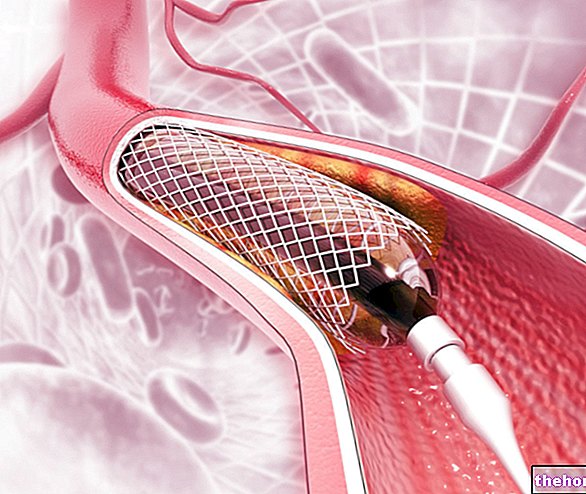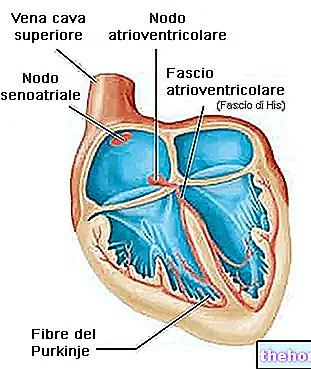Generality
An enlarged heart is a "cardiac anomaly marked, on X-ray examination, by an increase in the size of the heart."
Its appearance may be due to different pathological conditions, which may not directly affect the heart. In fact, among the main triggering causes, in addition to heart attack, cardiac arrhythmias, dilated cardiomyopathy, etc., hypertension, anemia and hemochromatosis also appear.
The most characteristic (although not always present) symptoms of an enlarged heart consist of shortness of breath, leg edema, palpitations and changes in the heart rhythm.
By performing various diagnostic tests, it is possible to establish the characteristics of the enlarged heart and where it originated.
Knowing the causes is essential for planning the right therapy.
.

Figure: a normal heart compared to an enlarged heart. The enlarged heart can become enlarged following a thickening of the myocardial walls or following a dilation of the atrial and / or ventricular cavities.
What is the enlarged heart?
Also known as cardiomegaly, the so-called enlarged heart represents a "cardiac anomaly detectable on X-rays, characterized by an increase in the volume or mass of the heart.
From a purely anatomical point of view, a thickening of the heart muscle (ie the myocardium) or a dilation of the atrial and / or ventricular cavities can determine the dimensional variations.
IS IT A SYMPTOM OR A DISEASE?
In medicine, an enlarged heart is considered a symptom and not a disease.
WHAT IS MYCARDIUM?
The myocardium is the muscle of the heart.
Alternating a contraction phase with a relaxation phase, the muscle fibers that compose it allow the heart to pump blood to the lungs (for blood oxygenation) and to the rest of the body (for nourishment of the various organs and tissues of the " body).
The myocardium has the extraordinary ability to generate the impulses for its own contraction by itself, thanks to the sinoatrial node. The sinoatrial node, located at the level of the right atrium, is the source and center of regulation of the heartbeat.

Figure: Anatomy and blood circulation inside the heart. The heart is divided into two halves, right and left. The right heart is made up of the right atrium and the underlying right ventricle. The left heart is made up of the left atrium and the underlying left ventricle. Each atrium is connected to the underlying ventricle by means of a valve.
Causes
Cardiomegaly usually arises as a result of particular pathological conditions, which concern the heart and beyond. In addition, there are cases of idiopathic cardiomegaly (for which no real cause is found) and others due to transient situations, such as pregnancy.
CARDIAC PROBLEMS AT THE BASE OF ENLARGED HEART
Heart problems and diseases underlying the enlarged heart work by making it more difficult for the heart to pump or by damaging the myocardium. They consist of:
- Heart attack. It is a serious heart disease, commonly called heart attack, caused by "interruption of blood flow to a more or less extensive part of the myocardium. At the origin of most cases of heart attack are coronary heart disease, or diseases of the coronary arteries.
- Arrhythmias. They are alterations in the heart rhythm. The latter, following an arrhythmia, can become too slow, too fast or irregular.
- Congenital heart defects. The term congenital indicates that the defect is present from birth.
- Defects of heart valves. There are four heart valves and they regulate blood flow between atria and ventricles and between ventricles and efferent vessels.
- Dilated cardiomyopathy. The term dilated cardiomyopathy identifies a disorder characterized by the thickening of the walls of the heart, in particular those of the ventricles.
- Pulmonary hypertension due to heart disease. High blood pressure in the pulmonary artery, which carries blood from the heart to the lungs, can first cause the right ventricle and then the right atrium to enlarge.
- Pericardial effusion. The heart is surrounded by a membrane, the pericardium, which contains a fluid called pericardial fluid. Excessive collection of pericardial fluid causes the so-called phenomenon of pericardial effusion; one of the most serious consequences of pericardial effusion is cardiac tamponade.
- Amyloidosis in localized form. Amyloidosis includes a group of diseases characterized by the accumulation of abnormal protein material, also called amyloid material, in the tissues of the body. Amyloidosis affects the heart when the accumulation of amyloid material occurs in the heart compartment.
- Infections viral of the heart. They cause "inflammation of the myocardium (myocarditis).
OTHER PATHOLOGICAL CONDITIONS AT THE BASE OF THE ENLARGED HEART
An enlarged heart can also arise as a result of one of the following pathological conditions:
- Hypertension. High blood pressure, hindering the normal pumping function of the heart, initially causes an enlargement of the left ventricle and then of the upper atrium.
- Anemia. Anemia concerns the red blood cells and the hemoglobin they contain, the deficiency of which leads to "inadequate oxygenation of the tissues and organs of the body. A" chronic anemia causes the heart of those affected to do a job more intense. More intense work can result in abnormal dilation of the heart cavities (atria and ventricles).
- Diseases of the thyroid gland. Hypothyroidism and hyperthyroidism can subject the heart to excessive stress, which dilates the heart cavities.
- Hemochromatosis. It is a disease, both hereditary and acquired, characterized by the "abnormal accumulation of iron in the tissues of the body".
Other causes of an enlarged heart:
- Pregnancy
- Alcohol abuse
- Drug use
- Kidney failure. If the kidneys are diseased, the heart struggles to pump blood and changes its normal anatomy.
Symptoms and Complications
The enlarged heart may be asymptomatic, meaning no obvious symptoms and signs, or cause shortness of breath, changes in the heart rhythm (arrhythmias), swelling (or edema) in the legs, palpitations, fatigue and weight gain
WHEN TO SEE THE DOCTOR?
An early diagnosis of an enlarged heart makes its treatment easier. Therefore, at the first signs of a possible heart problem, it is advisable to request a cardiological consultation, in order to identify the nature of the disorder.
COMPLICATIONS
The appearance of complications due to cardiomegaly depends on the underlying causes of the enlargement (for example, a pregnancy is a transitory situation and less dangerous than a heart attack) and on the anatomical part of the heart involved.
The most common complications are:
- Heart failure. Heart failure is a very serious pathological condition, which affects the left ventricle. The latter undergoes a dilation that tends to strongly weaken the pumping action of the heart.
- Formation of clots sanguine. An enlarged heart due to severe heart problems can lead to blood clots forming inside it. Blood clots can obstruct the blood flow circulating in the heart or surrounding vessels, causing a heart attack or stroke. If clots form in the right half of the heart they can travel to the lungs, resulting in a so-called pulmonary embolism.
- Heart valve disorders (or valvulopathies). Two of the four heart valves, the mitral and tricuspid, can deform (in some cases it is an additional malformation) and cause the blood to flow incorrectly. This determines the appearance of so-called heart murmurs.
- Cardiac arrest or sudden cardiac death. When the heart is enlarged, the signals for cardiac contraction can be "altered, resulting in an" arrhythmia. If the arrhythmia is severe (for example, ventricular fibrillation), the individual who suffers from it may experience cardiac arrest.
Diagnosis
The diagnosis of an enlarged heart requires a careful physical examination, aimed at observing the signs and symptoms, accompanied by the execution of other test, such as chest x-ray, electrocardiogram, echocardiogram, stress test, CT scan, nuclear magnetic resonance, blood tests, and cardiac catheterization biopsy.
The investigations must be scrupulous, since, in order to cure the enlarged heart in the best possible way, it is necessary to know in depth the causes and characteristics of the anomaly.
OBJECTIVE EXAMINATION
During the physical examination, the doctor analyzes the patient's signs and medical history.
The typical manifestations of a heart disease (i.e. chest pain, shortness of breath, fainting, arrhythmia, palpitations, heart murmurs, etc.) and the favoring situations, such as a found hypertension, a family history of an enlarged heart, are very important clues. a "congenital heart anomaly etc.
The physical examination is important, but not sufficient, especially if the sick individual has an asymptomatic form of cardiomegaly.
RADIOGRAPHY OF THE CHEST, CT AND NUCLEAR MAGNETIC RESONANCE
Chest x-ray (or chest x-ray), CT scan (or computed axial tomography) and nuclear magnetic resonance (or MRI) are diagnostic imaging tests that show the shape and size of the heart, proving to be very useful because they changes in the volume of the heart are highlighted.
N.B: chest X-ray and CT scan, unlike MRI, expose the patient to a minimum amount of harmful ionizing radiation.
ELECTROCARDIOGRAM
The electrocardiogram (ECG) measures the electrical activity of the heart through the application, on the chest and limbs, of some electrodes. By recording how the signal for cardiac contraction is conducted, the cardiologist is able to detect the presence of arrhythmias or damage from a previous heart attack.
The ECG is a fairly simple examination, it does not require special preparation, it is not invasive and it gives an idea of what may be at the origin of the enlarged heart.
ECHOCARDIOGRAM
The echocardiogram is an ultrasound examination that shows, in detail, the anatomy of the heart. It allows to identify valve defects, congenital heart defects, myocardial malformations (including cardiac cavity dilations and wall thickening) and blood pumping difficulties.
The echocardiogram, like the ECG, is a simple and non-invasive examination.
STRESS TEST
The stress test is the assessment of how an individual's heart works during physical activity.
It requires that, during a very simple exercise test such as walking on a treadmill or pedaling on an exercise bike, certain vital parameters are measured, such as heart rate, blood pressure and breathing.
BLOOD ANALYSIS
Blood tests allow you to measure the levels of certain substances, which, if above normal, could explain why the heart has become enlarged.
CARDIAC BIOPSY THROUGH CATHETERISM
Cardiac biopsy by catheterization takes place with a catheter which, inserted into an "artery of the body and taken to the heart, allows the collection of a small piece of tissue.
It is an invasive test and not without risks, however it offers the possibility of analyzing abnormal heart tissue in the laboratory.
Treatment
As anticipated, in order to cure an enlarged heart (or at least reduce its symptoms), it is necessary to know the causes.
Therefore, therapy depends on what is causing the cardiac abnormality.
The therapeutic treatments currently available are pharmacological (for less severe cases) and medical-surgical (for more severe cases).
PHARMACOLOGICAL THERAPY
Drug therapy is suitable for less severe cases of enlarged heart. It consists of the administration of one or more of the following drugs:
- Diuretics. By increasing daily diuresis, they favor the elimination of sodium present in the body and the lowering of blood pressure. They are particularly indicated in cases of enlarged heart due to hypertension and / or characterized by edema.
- ACE inhibitors (or angiotensin converting enzyme inhibitors). They are used in cases of enlarged heart sustained by hypertension, as they are effective in lowering blood pressure. The most widely used ACE inhibitors are captopril, enalapril and lisinopril.
- Angiotensin receptor blockers (or sartans). They have the same effects as ACE inhibitors, so they work against the hypertension underlying the enlarged heart.
- Digoxin. It is an ideal drug for increasing the contraction force of the myocardium and consequently improving the pump function of the heart. Digoxin is given when there is insufficient blood distribution to tissues and organs.
- Anticoagulants. As you can guess from the name, they are drugs that act against blood clotting. They are given to dissolve or to prevent blood clots from forming. The presence of the latter, in fact, can cause a stroke or a heart attack.
- Beta blockers. They are class II antiarrhythmic drugs, which are used to lower blood pressure (hypertension) and to slow the heart rate when it is high and above normal levels. One of the most widely used beta blockers is metoprolol.
- Antiarrhythmics of other classes. In addition to beta-blockers (class II), there are sodium channel blockers (class I), potassium channel blockers (class III) and calcium channel blockers (class IV). Each class has slightly different characteristics, but, in general, they all have the goal of keeping the heart rhythm stable.
MEDICAL-SURGICAL THERAPY
If drug therapy is ineffective, or if the condition of the patient with an enlarged heart worsens, a more marked and invasive medical-surgical intervention is required.
The possible treatments, in these cases, consist in the installation of a pacemaker or an implantable cardioverter defibrillator (ICD), in valve surgery, in coronary bypass, in the insertion of a ventricular assist device and, finally, in heart transplant. .
Installing a pacemaker or implantable cardioverter defibrillator (ICD). The pacemaker and the ICD are two small devices which, connected to the heart via different leads, monitor and maintain normal heart contraction and rhythm. A pacemaker and an ICD last on average 7/8 years, after which they must be replaced.
Valve surgery. If at the origin of the enlarged heart there is an "imperfection of the heart valves, it may be necessary to have surgery. The" valve surgery consists in replacing the defective valve with a mechanical or biological one.
Coronary bypass. Coronary artery bypass surgery is required when the coronary arteries of the heart have partial or complete obstruction, which prevents the blood from properly oxygenating the myocardium. Its purpose is to "build" an artificial bridge (called bypass), which bypasses the obstacle located at the level of the coronary arteries.
Inserting a ventricular assist device. The ventricular assist device (VAD) is a mechanical implantable pump that replaces the heart when it is unable to perform its normal function. This is usually a temporary remedy, waiting for a "new" heart to be transplanted. The insertion of the VAD is particularly indicated in cases where severe heart failure has been added to the enlarged heart.
Heart transplant. Patients in the worst condition may need a "new" heart from a compatible donor. Heart transplantation is a very complicated operation, which even when it is successful could lead to various complications, including rejection.
SOME USEFUL ADVICE
In the case of an enlarged heart, it is essential to adopt a healthy lifestyle, i.e. not smoking, losing excess weight, limiting the salt taken in the diet, controlling blood sugar, maintaining blood pressure at normal levels, exercising according to what prescribed by the doctor, moderate alcohol intake, do not use drugs and finally sleep 7-8 hours a night.
Prevention
To prevent an enlarged heart, the best thing to do is to keep the factors that favor its occurrence under control.
Therefore, it is a good idea:
-
List of the main risk factors for an enlarged heart:
- Hypertension
- Family history of enlarged heart or dilated cardiomyopathy
- Coronary heart disease
- Congenital heart disease
- Heart valve dysfunction
- Heart attack
- Hypertension
And
- Undergo periodic cardiological checks if you belong to a family with certain heart problems, such as dilated cardiomyopathy. Only in this way, in fact, is it possible to identify (and treat) the enlarged heart at the beginning.



















-nelle-carni-di-maiale.jpg)








